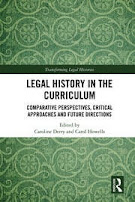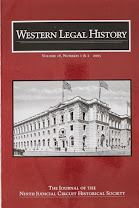- Northwestern Law has a post on the grants Ajay K. Mehrotra received in support of his book project, “American Outlier: Economic Inequality and the U.S. Historical Resistance to National Consumption Taxes.” On that NEH grant, though, see this and this.
- Columbia Law's notice of new faculty member and legal historian Kate Redburn.
- Congratulations to Laura Flannigan, University of Oxford, for winning the Royal Historical Society's first book prize for Royal Justice and the Making of the Tudor Commonwealth, 1485–1547 (Cambridge University Press, 2023).
- Balkinization has completed its symposium in honor of Ken Kersch. Contributors were Jack Balkin, Rogers M. Smith, Mark A. Graber, Sanford Levinson, George Thomas, Mary Ziegler, James E. Fleming, Linda C. McClain, Carol J. Nackenoff, Logan E. Sawyer III, and Dennis J. Wieboldt III.
- Also over at Balkinization, Gerard Magliocca ponders "The Mystery of Birch Bayh's Amicus Brief in Reed v. Reed."
- Samantha Barbas, Iowa Law, recently spoke on the history of freedom of speech and press at the Aspen Ideas Festival.
- Over three days in October, Maggie Blackhawk, NYU Law, will deliver the 2025 Rothbaum Distinguished Lecture in Representative Government at the University of Oklahoma. Professor Blackhawk's topic is Colonial Administration: Empire, Civilization, and the Making of Political Science.
- "The Margery Hunter Brown Indian Law Clinic at the University of Montana has embarked on an ambitious project to create the Indian Law Portal – a comprehensive digital archive of legal documents from each of Montana’s tribal nations" (University of Montana).
- "Preliminary report into Indian boarding school history lays the groundwork for dismantling policies that have harmed Indigenous people" (Washington State Attorney General).
- “Becoming Thurgood: America’s Social Architect,” a new one-hour documentary, premieres on Tuesday, September 9, on PBS. "What sets this film apart is that for the first time, [Thurgood] Marshall’s story is told in his own words—drawn from a rare eight-hour oral history recording" Chicago Defender).
- Time's Made by History: Ryan LaRochelle and Kate Flynn say that History Shows us Why a Non-Partisan U.S. Military is Essential.
- At Inside Higher Ed: Michael Bannerjee (UC Berkeley) draws on the 1819 Dartmouth College case to argue that "Universities Need to Go Corporate"; doing so could "preserve institutional autonomy and defend academic freedom."
- How the Heritage and the US Department of Education would have us observe the 250th.
- The Institute of Historical Research has posted online its archive of interviews with UK historians, including Christopher Hill, Eric Hobsbawm, E P Thompson, Dorothy Thompson, and Maurice Cowling (History and Policy).
- The comments on that proposal of the American Bar Association to double the number of required experiential credit hours from six to twelve have been posted online and are summarized here. Mine is one of them. DRE
- The July 2025 newsletter of the Historical Society of the D.C. Circuit is now available here.
- ICYMI: Brandan Buck on the Lost Liberalism of America First (Cato). Noria Doyle on How Plessy v. Ferguson sparked early civil rights activism from Milwaukee’s Black community in 1896 (Milwaukee Independent). Alexis Coe, American History columnist for the NYTBR, lists some books to read on the US Supreme Court in "this moment of constitutional crisis" (NYT). The rare book collection of the the Indiana Supreme Court Law Library (Indiana Lawyer). Justice Jackson's inclusive original public meaning (Slate).
Weekend Roundup is a weekly feature compiled by all the Legal History bloggers.


















